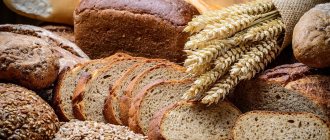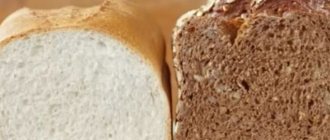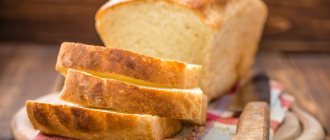What is mold?
Mold is a member of the fungal kingdom, which is separate in the classification of plants and animals. Common edible mushrooms also fall into this category. These are organisms that do not require chlorophyll, so they do not receive energy directly from the sun. This means that fungi must use plants and animals as a food source. This is why bread is moldy: because of the ingredients in its composition, it is an excellent source of food for many types of fungi.
What to do if the product is moldy
Most foods with visible signs of mold contamination should not be eaten. Molds poison food with mycotoxins, which can cause irreparable harm to the body. The poisons released by mold can cause liver damage, pulmonary edema, impaired kidney function, and even the development of cancer.
Food contaminated with mold should be thrown away, even if only 2-3 small colored spots appear on it. Do not forget that behind the visible part of the mycelium there are numerous invisible threads of the mycelium that penetrate the spoiled product like laser beams.
► Only hard cheeses, dry-cured sausages and dried meats can be “saved” and eaten. With meat products, it is enough to remove the plaque that appears on the surface, and with hard cheeses, cut off the top layer 1 cm thick.
► We mercilessly throw away the rest - including boiled sausages, sausages, ham, bread, sour cream, cottage cheese, ready-made meals, jam, berries, fruits and vegetables.
How does she get into our house?
Mold gets onto bread through spores in the air. Although you cannot see them, there are millions of them around you.
These spores can accumulate in dust around your home, which is kicked up by sweeping, wind, or simply someone passing by. Spores can enter your home, settle on the bread, and the mold process will begin. Mold lives and feeds on bread. That's why it can quickly cover an entire loaf if you let it. Mold reproduces at a high rate - sometimes it can double in size within an hour.
Which foods go moldy faster?
Mold loves moisture, so it attacks any food product that contains it. Products with a high level of humidity become infected faster than others, including vegetables (up to 96-97%), bread (30-50%), sausages (30-60%) and cheeses (20-40%).
The rate of mold contamination of products largely depends on storage conditions:
► Products in open packaging, wet greens, vegetables and fruits with damage and cuts will quickly become moldy.
► If the mycelium already “lives” on the walls of the refrigerator, kitchen cabinet or bread bin, mold will appear even on fresh food.
► If you put the product in a “non-breathable” plastic bag, the moisture released will settle on the walls and provoke accelerated development of the mycelium.
What kind of mold is there?
Penicillin is the first antibiotic created from the fungus penicillium chrysogenum, and this discovery belongs to Alexander Fleming, a great scientist. It is found in noble blue cheeses and is very beneficial for the body. But not all mold is beneficial. It comes in different colors.
Black most often covers old bread. Greenish-blue - cheese. Green fuzz usually develops on oranges that have been left in a humid environment for too long. Mushrooms are a great boon to humanity. Without yeast there would be no bread or beer. Mushrooms are used to make antibiotics, soy sauce, miso, sake, tofu, and many other products.
On the other hand, many plant diseases that result in their death are caused by mold. The Irish famine was caused by potato late blight. Most of America's great chestnut forests have been destroyed in 50 years by a fungus brought to the United States on a tree planted in a botanical garden. Fungi are responsible for trillions of dollars in food spoilage damage each year worldwide.
How long does bread stay fresh?
The shelf life of a baked product is the time during which it remains soft. For baked goods stored outdoors, it is short, only 24-36 hours.
Packaged baked goods retain freshness much longer. In this case, the shelf life primarily depends on the type of flour that was used during kneading. What is the shelf life of different types of packaged bread?
- Yeast wheat - 3 days.
- Rye-wheat – 4 days.
- Rye and Borodinsky - 5 days.
- Whole grain and hearth – 7 days.
Barley and corn bread spoil most quickly, as well as baked goods made from finely ground premium wheat flour.
What else affects the shelf life of baked goods?
- Fermentation technology. A yeast-free product mixed with sourdough remains soft twice as long as its yeast counterpart.
- Baking time. Poorly baked bread may become moldy the very next day after purchase.
- Size and density of the loaf. The heavier and larger the loaf, the longer it will not go stale. Products that are too loose and small will become hard in less than a day.
- Air temperature and humidity. The optimal temperature is 25° above 0 and humidity 75%. At low temperatures above zero, the product quickly loses moisture; at high humidity, it becomes covered with mold.
- Compound. To prevent it from going stale for a long time, add vegetable oil or butter and eggs to the loaf.
In most cases, the “long life” of a product with a shelf life of 2 weeks is ensured by preservatives and thickeners. One of the exceptions is bread prepared using a special technology. For example, Westphalian pumpernickel in special packaging remains fresh for 24 months.
Is mold a plant or a mushroom?
Have you ever opened a loaf of bread that has been sitting in the kitchen for a long time and seen dark colored stains? This is mold. What happens when you leave the bread open a little longer? The mold spreads quickly and all the bread turns green or black and looks very unappetizing.
But mold is a simple fungus that takes nutrients from bread for its growth and reproduction and damages its surface. Mold grows on bread from microscopic fungi belonging to various species. They come in different shapes and colors depending on the species.
Rhizopus stolonifer (black mold) is the most common mold on bread, which also grows very quickly. It also causes rotting of fruits and some infections in the human body. Microscopic pieces of moldy bread, known as spores, float in the air around us. They can be found on any surface and in any conditions. It is the spores that land on the surface of the bread, which can be left open under normal conditions, say, in the kitchen. They germinate and form colonies that begin to grow on the surface of the bread, absorbing all the moisture and nutrients from it. The growth rate of bread mold depends on several factors, and ambient temperature is the most important of them.
How mold “settles” on food
Invisible to the eye, spores (reproductive organs) of mold fungi are everywhere. They are present in the natural air environment around us along with other microorganisms - viruses and bacteria.
But mold spores don't fly through the air forever. When they enter a humid environment favorable for reproduction, they anchor and settle on the surface of the product, on which branching mycelium (mycelium) begins to grow rapidly. After some time, visible signs of infection appear on the food - colored spots, white coating or voluminous fluffy “caps”.
Causes of mold growth and ways to slow it down
Mold growth will be slowed down if bread is stored in the refrigerator. It should be noted that most molds thrive in temperatures above 70°C, and low refrigerator temperatures are unfavorable for mold. Place a slice of bread in the freezer and mold growth will stop completely until the temperature rises to a favorable temperature.
Why does bread get moldy? Bread mold is a living organism that requires moisture and oxygen to grow. The moisture in the plastic bag allows the fungus to grow at a faster rate. However, since it is considered a fungus and not a plant, it does not require sunlight to increase or decrease its growth rate.
How to properly store bread in the freezer
Sometimes it becomes necessary to keep the loaves edible for 2 weeks or more. This is possible using a freezer.
A product frozen according to instructions and properly thawed is no different from a freshly baked product. Retains moisture, remains appetizing and soft.
Cut the bun into portions. Place in paper and plastic bag. Remove the air from the packaging and place in the freezer. Set the temperature to 20 C.
Stored at temperatures up to – 18 C for 3-4 months.
Thaw it indoors before eating. It will take 2 hours. Do not freeze the loaf the second time!
If you follow the storage rules, the bread will remain fresh and tasty.
Drying crackers
Crackers are one of the ways to preserve baked goods. The dried pieces are thrown into soup or borscht. If necessary, reheat by steaming.
Drying crackers at home is easy. An accessible method is oven drying:
- cut the bun into pieces;
- spread on a sheet in one layer;
- place in the oven, heated to 120-130 C;
- leave for 10 minutes;
- turn the pieces over and cook until browned, 8 minutes.
The preparation time for crackers is half an hour. For uniform drying, it is advisable to cut pieces of the same size.
Let's conduct an experiment and find out how and why bread becomes moldy
We will need:
- fresh bread from the bakery;
- cotton pad;
- pipette;
- water;
- plastic bag;
- scotch;
- empty milk carton;
- disposable gloves.
Experiment:
- Use a small cotton pad to collect some dust from the ground.
- Rub it over a piece of fresh bread.
- Using a dropper, place five to six drops of water on a slice of bread.
- Place it in a plastic bag and seal it.
- Now place this sealed bag of bread in an empty milk carton.
- Close the box tightly with tape.
- Leave the box alone for two days.
What do you observe when you open the package after two days? The bread is completely covered with fluffy black or greenish spots. Why does bread get moldy? The dust that was placed on the bread carried fungal spores, which caused mold to grow on it.
Convenient storage in fabric and polyethylene
Bread and bakery products are stored in different ways. Some housewives prefer fabric bags, others prefer plastic bags.
In addition to ordinary bags, pieces of flax or canvas are used. Wrap it up and put it in the closet. This keeps the product fresh and fluffy for 3-4 days. Then it becomes stale, but does not lose its taste.
It is recommended to wash the fabric or storage bag 2-3 times a month. Use unscented soap and do not use powders with fragrances. Additives in detergents affect the quality of the product.
Plastic bags keep bread loaves fresh for 5 days. It is important that the loaf is clean and dry. A polyethylene bag retains moisture and prevents the loaf from becoming stale and dry out.
But at the same time, the material increases the accumulation of condensation. High humidity creates an environment inside the bag that is favorable for the growth of bacteria.
That's why the bag needs holes. You can pierce the holes with a fork or knife.
The factory packaging initially contains round holes. Air enters and prevents the appearance of wet spots and mold.
Mold prevention
- Why does bread get moldy quickly? Moisture encourages mold to grow faster. Therefore, do not store bread in a humid environment. It's best to leave it in the same bag you brought it in from the bakery.
- Why does store bought bread get moldy? Most likely, it contains fats or old bread was used in its preparation. If you are making bread at home, use ingredients that do not contain fat rather than oil, eggs, milk, etc. This will help the bread stay fresh for longer.
- A bread box is another option for storing bread for a long time. A selection of bread bins made from wood, clay and metal are best for storing bread as they can keep it dry and do not accumulate moisture.
- Why does sourdough bread get moldy? Most likely because it was packaged too hot or the bun was too large.
- Never store bread at room temperature or in the refrigerator for an extended period. Freezing will be useful if long-term storage is required.
- Preserving bread during the summer requires a little extra effort. Do not store bread in a plastic airtight container, but if you have a homemade or sliced loaf, wrap it in wax paper and place it in a plastic container with a tight-fitting lid.
- Finally, try to consume bread and other similar foods as fresh as possible. If you see mold just appearing on food, do not try to cut it out and then eat the product. Remember that mold has already grown from the inside.
- Why does Borodino bread not mold? Its acidity is higher than usual, this prevents mold from growing.
Bonus for readers: we answer a subscriber’s question about lavash
“Good afternoon, I bought lavash yesterday, but this morning it became moldy and I had to throw it away. But if mold grows for several days, does that mean that if I had eaten it yesterday, I would have eaten pita bread that was already affected by fungi?”
– If yesterday there was no mold, no visible signs, no changes in smell or taste, then at that time the product was safe for consumption. If there was even a speck of mold on the lavash that you might not have noticed, alas, the lavash is already in the risk category, says Olesya Savkina
. – Our long-term research shows that, on average, visible mold colonies appear on the surface of baked goods within 3–7 days. In conditions favorable for mold, this period can be reduced to 1–2 days. Lavash is one of the most susceptible products to mold. But since it takes at least 24 hours for mold to develop from spores on the surface of pita bread, we can say that the product was safe the day before. Once the mold has sprouted, the product becomes unfit for consumption.
Take the TEST
and find out
what kind of furfural you are
. No joke, it helps you understand how safe what you eat is.
Thank you for reading this text to the end. Follow the news, subscribe
mail.
When quoting this material, active link to the source
required.
Harm from mold to humans
Moldy bread contains spores and therefore should not be touched with bare hands. Remember: bread mold is real poison! After consuming such bread, an adult can become poisoned, and a child can end up in intensive care. If you frequently eat moldy bread, you may develop asthma, allergies, or even oncology.
Mold poisoning may cause the following symptoms: dizziness, nausea and vomiting, headaches, diarrhea. Black mold is considered especially dangerous. The symptoms are similar to colds, so they may not immediately alert a person. And at this time the body is already poisoned, and the patient’s condition worsens: blood pressure jumps, breathing problems and headaches appear. In any such situation, you should immediately seek medical help.
Choosing a bread box
Where is bread traditionally stored in the kitchen? The answer is obvious: in the bread bin. To ensure that the product does not spoil for a long time, you first need to choose it wisely. Which bread box is best? Let's consider the options.
- Plastic. Its advantage is practicality. The plastic container can be completely washed and treated with a disinfectant. It does not break and, unless excessive force is applied to it, does not break. A plastic bread bin is a good choice, as long as it doesn't emit a strong odor and has ventilation holes.
- Wooden. It is the most environmentally friendly. However, it does have its drawbacks. If it gets very wet or stays in the sun for a long time, the glued parts of the container dry out. In addition, it is very difficult to remove old dirt and grease from wood.
- Metal. Having chosen this version of the bread box, pay attention to what metal it is made of. The ideal option is stainless steel. It does not rust, does not absorb odors and does not form condensation.
You should not place the breadbox above the stove, or place it near the radiator in winter or on a too-highly lit windowsill in summer. Baked goods in it will quickly spoil.
How to get rid of mold at home and avoid its recurrence
- To prevent the loaf from molding, ventilate the kitchen and wash the bread bin before putting in a fresh one. And if only one type of bread goes bad, it’s better to choose another type or manufacturer.
- Before placing the loaf, wrap it in linen or cotton cloth. Wash the fabric used to wrap the loaf with fragrance-free laundry or baby soap.
- If you store the bun in a plastic bag, poke holes in it.
- Sew a bag for the bread box and put it in a saline solution for a day (2 tablespoons of salt per half liter of water), and then dry it without rinsing. In such a bag the buns will not become moldy.
- To protect the bread box from molding, place an apple slice or a pinch of iodized salt in gauze.
- Cut the loaf in half and cut new pieces from the middle. When putting away for storage, connect the sections. This way the inside will not become stale and moldy.
We recommend reading: “How to keep food from mold”
These simple tips will help keep your loaf fresh for a long time and protect it from mold. However, the bun is not a long-term storage product, so you should not buy it in reserve. And there has been no shortage in stores for a long time.
How to bring freshness back to a loaf
If a baked product becomes moldy, it will have to be thrown away. But a dried product can be given a second life.
- The remaining large quantities of chopped pieces are placed in the oven and dried. Bread crumbs can be eaten immediately after preparation or placed in a cloth bag for use in home cooking. Properly dried slices can be stored for more than six months.
- If large shapeless pieces have turned into crackers, they are placed in a dry, clean bag. When there is a lot of leftovers, they are broken up with a blender or turned through a meat grinder, turning them into bread crumbs.
Slightly dried bread can be softened in several ways:
- Spray the loaf with water and place in the microwave at medium power.
- Arrange the chopped slices in a circle on a flat plate, and place a container of water in the middle. Microwave for about 20 seconds.
- Wrap the moistened loaf in foil and place in the oven for a quarter of an hour at 180°.
- Fill a wide saucepan a quarter full with boiling water and put it on the fire. When the water boils again, place a smaller container with bread inside it. Keep the pan over low heat until a characteristic bready smell appears.
- Place the loaf in the slow cooker and wait 2 minutes.
As you can see, with the right approach, you can keep bread fresh not only during its standard shelf life. In the refrigerator it will “live” from the full period indicated by the manufacturer on the packaging to a month. And if dried, it will be stored for more than six months.











